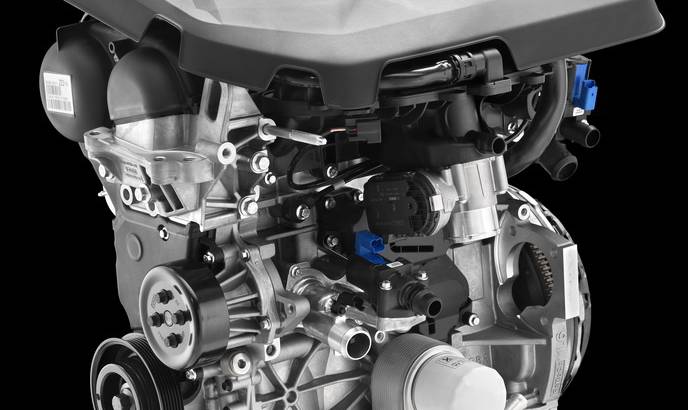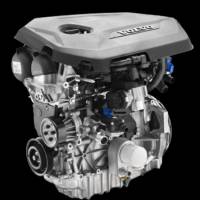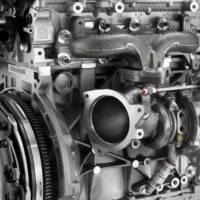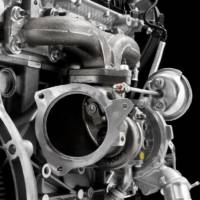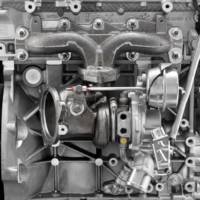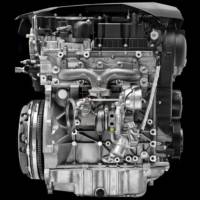Volvo is introducing the company’s new 1.6-litre T3 and T4 petrol engines which feature the latest direct injection technology, offering 150 HP and 180 HP respectively and which feature improved fuel consumption figures.
The new 1.6-litre GTDi 4-cylinder T3 petrol unit that packs 150 HP (110 kW) and 240 Nm of torque as well as the new 1.6 GTDi T4 producing 180 HP (132 kW) and 240 Nm of torque (270 Nm with overboost) will be offered on the new Volvo S60 and V60 models.
Both the new T3 and T4 engines will use Volvo’s 6-speed manual gearbox with the automatic 6-speed Powershift transmission also available on the T4.
Fuel consumption figures for the new Volvo 1.6-litre petrol engines were not specified, but the automaker did specify that their T3 and T4 units will be launched in autumn 2010 with a E85 capable version also in the works.
Volvo press release :
Volvo’s engine range is now being
expanded with the T3 and T4, two four-cylinder 1.6-litre petrol engines
featuring the very latest direct injection technology.
The
GTDi (Gasoline Turbocharged Direct Injection) concept was developed to
offer really low fuel consumption without compromising on performance or
driving pleasure.
The 1.6 GTDi T3
with 150 horsepower (110 kW) and the T4 with 180 horsepower (132 kW)
will be available in the all-new Volvo S60 and V60. The 180 hp engine
delivers maximum torque of 240 Newton metres from just 1600 and all the
way up to 5000 revs a minute. An on-demand overboost function provides a
massive 270 Newton metres of torque. The result is excellent pulling
power across the entire speed range. The torque curve is relatively
gentle, providing a particularly comfortable driving experience. The 150
hp version offers 240 Newton metres of torque.
"Small,
high-performance GTDi engines are a part of our bid to get more energy
out of smaller engines," says Magnus Jonsson, Senior Vice President
Product Development at Volvo Cars.
Compact aluminium engines with low weight and high energy efficiency
The
new GTDi engines have a compact format and are made entirely from
die-cast aluminium, which gives low weight and good heat-dissipation
capability. These are some of the requirements for good energy
efficiency. The plastic inlet manifold also helps minimise weight.
Another
precondition is maximum combustion of the fuel. In order to minimise
petrol consumption and emissions, the fuel must be utilised as
efficiently as possible. The fuel injection system, not least, has been
refined so that combustion can be regulated with extreme precision.
Direct injection with spray-dosage multi-hole injectors
For
its 1.6-litre engines, Volvo has chosen to position each injector
centrally above the piston, just beside the spark plug. The injectors
have six holes each, somewhat unusual for centrally positioned
injectors. This gives particularly uniform and finely atomised fuel
distribution.
The centrally located multi-hole
injector makes it possible to control fuel dosage extremely precisely.
In cold starts, the fuel is sprayed into the middle of the combustion
chamber just prior to ignition. The high fuel injection pressure of 100
bar means that preparation is perfect and less fuel ends up on the cold
combustion chamber walls. This helps cut emissions and considerably
reduces the amount of fuel consumed. Another effect is a major reduction
in the amount of soot particulates compared with a side-positioned
injector.
In cold starts, this injection technology
also contributes to quick heating of the catalytic converter, which in
turn hastens the exhaust cleaning process.
Direct
injection gives a high fill rate in the combustion chamber. Apart from
effective combustion and low emissions, this also helps the turbo start
up earlier and provides swift response even from low engine revs. This
in turn promotes fast acceleration and good driveability from low
speeds.
"This is the most modern injection technology
in existence and Volvo played a major role in its development," says
Magnus Jonsson. "Our cooperation with Bosch, which manufactures the
system, has been ongoing for a number of years and is highly
successful."
Turbo and twin VVT (Variable Valve Timing)
Direct
injection in combination with turbocharging and variable valve timing
has made it possible to deliver performance properties on a par with far
larger engines, while at the same time reducing fuel consumption and
environmental impact to considerably lower levels.
"We
estimate reductions in fuel consumption and exhaust emissions in the
region of twenty percent compared with a conventional petrol engine with
larger displacement and similar performance," says Magnus Jonsson. "At
the same time, the GTDi engines provide the sort of lugging power and
driving feel of a modern diesel engine."
The GTDi
engines utilise variable valve timing for both camshafts. Both the inlet
and exhaust valves’ opening times can be varied to optimise overlap and
ensure exactly the right fill in the combustion chamber, irrespective
of engine revs. This optimises combustion throughout the rev range and
contributes to swift acceleration in all operating conditions.
In combination with Powershift or manual gearbox
The
1.6 GTDi T4 will be available in combination with Volvo’s automatic
six-speed Powershift transmission or a six-speed manual gearbox.
The 1.6 GTDi T3 will only by available with a six-speed manual gearbox.
Both variants feature a DRIVe-button on the instrumentation that engages and disengages fuel-saving technology:
- The
automatic version had a technology that disengages the gear if the
driver releases the accelerator when the car is rolling. This creates
less rolling resistance and improves fuel consumption. - The
manual version comes with a Start/Stop function that shuts off the
engine when the car is standing still and the driver releases the clutch
and puts the gear lever into neutral. As soon as the driver presses the
clutch again the engine restarts.
The six-speed
twin-clutch Powershift transmission unites the manual gearbox’s
efficiency and driving dynamics with the automatic transmission’s
smoothness and convenience. Clutch operation is coordinated so that no
torque losses arise during gearchanges. The result is the same comfort
and seamless drive as a conventional automatic transmission, combined
with the performance of a manual gearbox.
Launch in autumn 2010
The
1.6 GTDi T3 and T4 is launched in autumn 2010 together with the new
Volvo S60 and V60. The GTDi engines will later also become available in
an E85 (ethanol) version.
Engine specifications 1.6 GTDi T3:
| Engine type | 4-cylinder petrol turbo |
| Displacement | 1595 cm3 |
| Bore | 79.0 mm |
| Stroke | 81.4 mm |
| Compression ratio | 10.0:1 |
| Valves per cylinder | 4 |
| Camshafts | DOHC |
| Max power output | 110 kW (150 hp) |
| Max torque | 240 Nm |
| Emissions | Euro 5 |
Engine specifications 1.6 GTDi T4:
| Engine type | 4-cylinder petrol turbo |
| Displacement | 1595 cm3 |
| Bore | 79.0 mm |
| Stroke | 81.4 mm |
| Compression ratio | 10.0:1 |
| Valves per cylinder | 4 |
| Camshafts | DOHC |
| Max power output | 132 kW (180 hp) / 5500 rpm |
| Max torque | 240 Nm / 1600-5000 rpm, 270 Nm for brief overboost |
| Emissions | Euro 5 |

